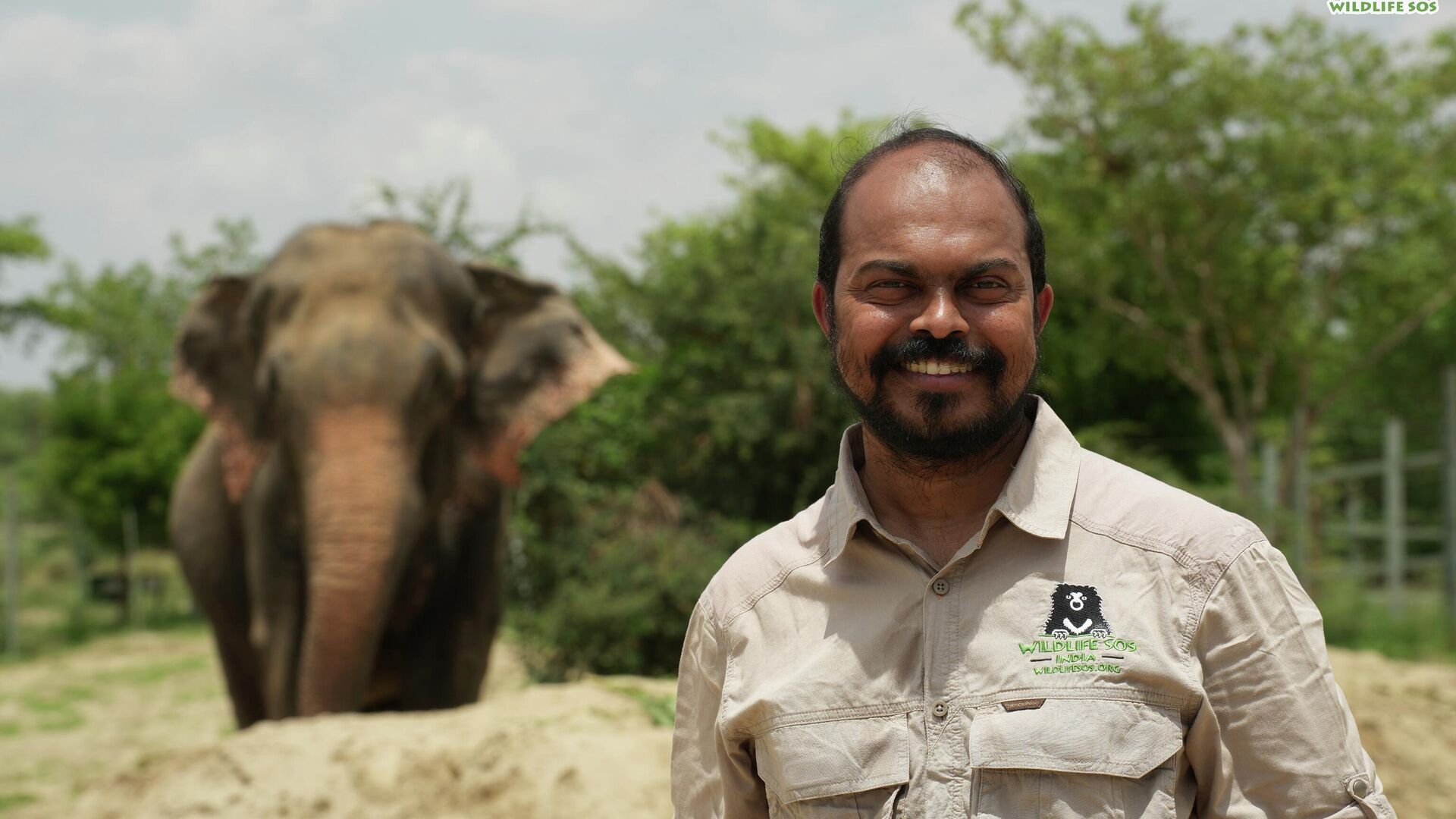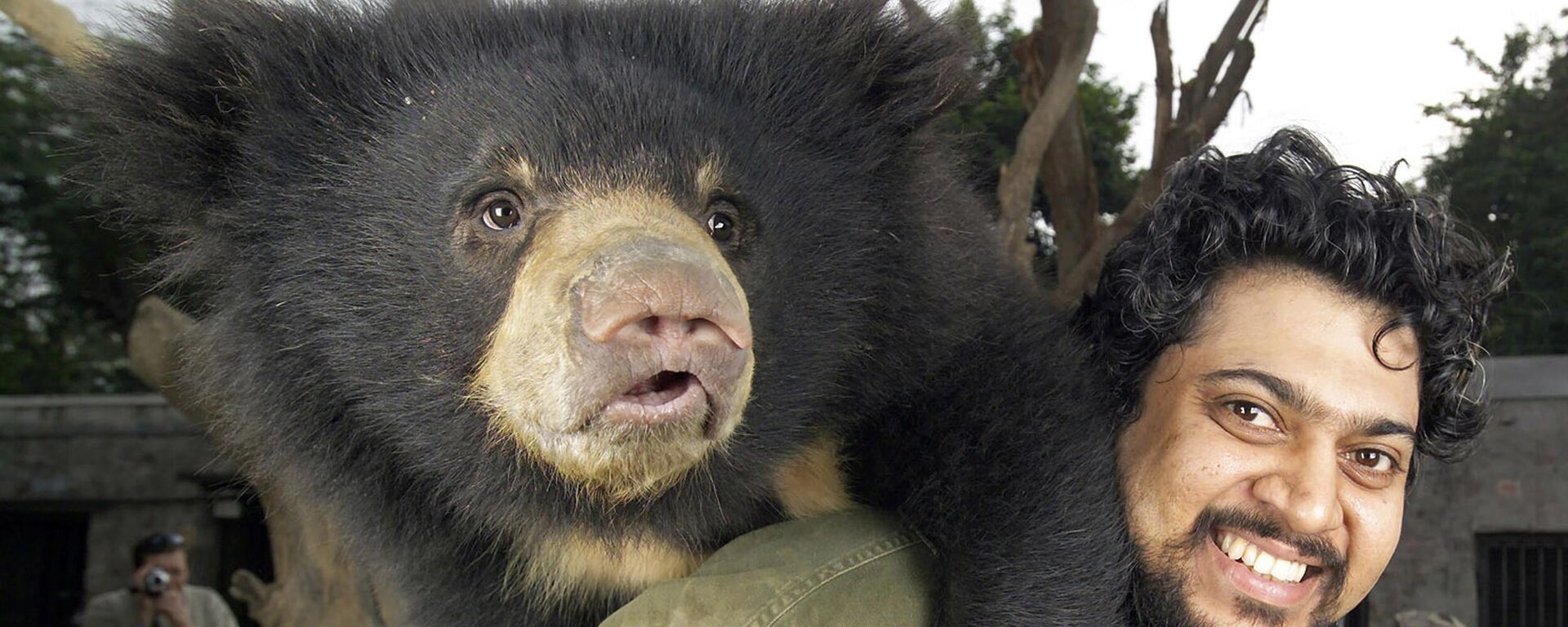https://sputniknews.in/20230812/world-elephant-day-what-makes-asian-elephants-intelligent-and-sociable-yet-endangered-3550079.html
World Elephant Day: What Makes Asian Elephants Intelligent and Sociable Yet Endangered?
World Elephant Day: What Makes Asian Elephants Intelligent and Sociable Yet Endangered?
Sputnik India
India is home to about 60% (around 26,000 to 28,000) of the Asian elephants in the world. Yet the elephants, also known as the ecosystem engineer, are endangered due to a rise in poaching, illegal captivity, habitat loss, and human-animal conflict.
2023-08-12T15:15+0530
2023-08-12T15:15+0530
2023-08-12T15:15+0530
sputnik exclusives
india
baby elephant
animal rights
animal extinction
sacred animal
wildlife
nature conservation
rescue operation
world population
https://cdn1.img.sputniknews.in/img/07e7/08/0b/3530335_0:160:3072:1888_1920x0_80_0_0_b210108788b184629a9b8b964ee3f7af.jpg
Elephants hold great significance in Indian mythology, ancient culture and history, from their symbolic reference to elephant-headed God ‘Lord Ganesha’ to the divine winged white elephant ‘Airavata’ who is said to be the celestial vehicle of Lord Indra.Even now, several Hindu devotees filled with reverence for elephants gather in the temples of South India to pay homage and receive blessings from these magnificent creatures, adorned in colorful fabrics and vibrant hues.Even in the legends of Buddhism, Maha Maya, the mother of Gautama Buddha, had a dream of a majestic white elephant, foretelling that her child would grow up to become either a great ruler or a revered saint.During the ancient Indian epic 'Mahabharat' and the Mughal era, elephants were tamed and used in warfare, extravagant wedding ceremonies, and for the construction of palaces and forts.Back in those days, kings and princes owning hundreds of elephants were considered to be a symbol of pride for the kingdom.Eco-System EngineersTouted to be “eco-system engineers”, elephants help maintain ecological balance by shaping the habitat and directly influencing forest composition.Elephants of TemplesThe majestic animal is greatly used for different ceremonial purposes at temples and weddings in India.“When I was a kid, I had gone to Thrissur Pooram, an annual Hindu temple festival. There were 105–110 elephants lined up, and it was a magnificent sight to see,” Baiju said.However, he pointed out, these elephants undergo real torture by their mahouts.This issue came to light after several horrifying videos of elephants being tortured and broken down went viral on social media.Under The Wild Life (Protection) Act, it is strictly prohibited to have elephants in captivity or possess them, as this law establishes a robust legal framework to safeguard a wide range of wild animal species.Since 2010, several forest departments across the state, along with Wildlife SOS, have been conducting rescue operations for elephants.Wildlife SOS has also launched an elephant helpline number for people to report cruelty towards the animal or seek medical assistance.Impact of Tourism Elephants are a big attraction to tourists and an easy money-making business for the owners. While some tourists like to get clicked with them, others demand to go for elephant rides.The demand for elephants to be brought from the wild to the concrete jungle is increasing due to activities such as elephant rides, tourism, and their use in ceremonies and marriages. 'Ultimately the elephant is suffering,' Baiju said.Wildlife SOS is spearheading a campaign called "Refuse to Ride" to raise awareness about the exploitation of elephants and urge people to refrain from riding or sitting on these magnificent creatures.Human-Animal ConflictMany viral videos of elephants walking on the streets in the cities have drawn attention to the rising issue of human-animal conflict.Due to forest fragmentation, several elephants migrated from Odisha to Chhattisgarh state, which was not an elephant range country. Because of the growing elephant population in Chhattisgarh in recent years, the state's forest department and wildlife reserves have come together to sign a crucial memorandum of understanding (MOU) aimed at radio-collaring these magnificent creatures.India's first and only elephant hospital, established by Wildlife SOS in the state of Uttar Pradesh, provides refuge and aid to injured elephants as a result of human-animal conflict, accidents, or illegal captivity.The need of the hour is to spread awareness about elephant cruelty and work collectively for its protection.
https://sputniknews.in/20230528/meet-bear-man-of-india-who-is-on-a-rescue-mission-to-save-wild-animals-2190706.html
india
Sputnik India
feedback.hindi@sputniknews.com
+74956456601
MIA „Rossiya Segodnya“
2023
Sangeeta Yadav
https://cdn1.img.sputniknews.in/img/07e6/0c/0f/110602_0:0:641:640_100x100_80_0_0_c298016a79eb02ef8caa9d1f688c12a5.jpg
Sangeeta Yadav
https://cdn1.img.sputniknews.in/img/07e6/0c/0f/110602_0:0:641:640_100x100_80_0_0_c298016a79eb02ef8caa9d1f688c12a5.jpg
News
en_IN
Sputnik India
feedback.hindi@sputniknews.com
+74956456601
MIA „Rossiya Segodnya“
Significance of elephants in Indian mythology [1]
Sputnik India
Significance of elephants in Indian mythology [1]
2023-08-12T15:15+0530
true
PT1M40S
Wildlife SOS work on elephant conservation [3]
Sputnik India
Wildlife SOS work on elephant conservation [3]
2023-08-12T15:15+0530
true
PT1M21S
Human-elephant conflict [2]
Sputnik India
Human-elephant conflict [2]
2023-08-12T15:15+0530
true
PT1M46S
Sputnik India
feedback.hindi@sputniknews.com
+74956456601
MIA „Rossiya Segodnya“
Sangeeta Yadav
https://cdn1.img.sputniknews.in/img/07e6/0c/0f/110602_0:0:641:640_100x100_80_0_0_c298016a79eb02ef8caa9d1f688c12a5.jpg
population of elephants in india, significance of elephants in indian mythology ancient culture history, elephant-headed god ‘lord ganesha’, winged white elephant ‘airavata’, lord indra, hindu mythology, vighnaharta, baiju raj m.v, director- conservation projects at wildlife sos, temples of south india, legends of buddhism, gautama buddha, majestic white elephant, ancient indian epic 'mahabharat', mughal era, elephants were tamed and used in warfare, extravagant wedding ceremonies, construction of palaces and forts, symbol of pride, eco-system engineers, ecological balance, habitat loss, poaching of elephants, elephants trafficking, elephants sold to temples, elephants tortured and breaking down, wild life (protection) act, rescue operations for elephants, elephant helpline number, cruelty towards animal, fake ownership certificates, elephants microchip, rehabilitation of elephants, treatment of injured elephants, tourist attraction, easy money making business, elephant rides, urban jungle, campaign, refuse to ride, raise awareness, exploitation of elephants, human-animal conflict, elephants radio-collared, mitigating human-animal conflict, india's first and only elephant hospital, elephant ambulance, mahout, cruel practice
population of elephants in india, significance of elephants in indian mythology ancient culture history, elephant-headed god ‘lord ganesha’, winged white elephant ‘airavata’, lord indra, hindu mythology, vighnaharta, baiju raj m.v, director- conservation projects at wildlife sos, temples of south india, legends of buddhism, gautama buddha, majestic white elephant, ancient indian epic 'mahabharat', mughal era, elephants were tamed and used in warfare, extravagant wedding ceremonies, construction of palaces and forts, symbol of pride, eco-system engineers, ecological balance, habitat loss, poaching of elephants, elephants trafficking, elephants sold to temples, elephants tortured and breaking down, wild life (protection) act, rescue operations for elephants, elephant helpline number, cruelty towards animal, fake ownership certificates, elephants microchip, rehabilitation of elephants, treatment of injured elephants, tourist attraction, easy money making business, elephant rides, urban jungle, campaign, refuse to ride, raise awareness, exploitation of elephants, human-animal conflict, elephants radio-collared, mitigating human-animal conflict, india's first and only elephant hospital, elephant ambulance, mahout, cruel practice
World Elephant Day: What Makes Asian Elephants Intelligent and Sociable Yet Endangered?
India is home to about 60% (around 26,000 to 28,000) of the Asian elephants in the world. Yet the elephants, also known as the ecosystem engineer, are endangered due to a rise in poaching, illegal captivity, habitat loss, and human-animal conflict.
Elephants hold great significance in Indian mythology, ancient culture and history, from their symbolic reference to elephant-headed God ‘Lord Ganesha’ to the divine winged white elephant ‘Airavata’ who is said to be the celestial vehicle of Lord Indra.
“In Hindu mythology, elephants are considered to be one of the forms of Lord Ganesha. They are also known as Vighnaharta, the force that removes all obstacles and negativity and worships them to bring luck and prosperity,” Baiju Raj M.V, the director of conservation projects at Wildlife SOS, told Sputnik News India.
Even now, several Hindu devotees filled with reverence for elephants gather in the temples of South India to pay homage and receive blessings from these magnificent creatures, adorned in colorful fabrics and vibrant hues.
Even in the legends of Buddhism, Maha Maya, the mother of Gautama Buddha, had a dream of a majestic white elephant, foretelling that her child would grow up to become either a great ruler or a revered saint.
During the ancient Indian epic 'Mahabharat' and the Mughal era, elephants were tamed and used in warfare, extravagant wedding ceremonies, and for the construction of palaces and forts.
Back in those days, kings and princes owning hundreds of elephants were considered to be a symbol of pride for the kingdom.
Touted to be “eco-system engineers”, elephants help maintain ecological balance by shaping the habitat and directly influencing forest composition.
“Elephants are the masters of the forest. With their strength and wisdom, the elephants break down trees and make paths and corridors for other animals. They are considered to be very important to the forest,” Baiju said.
The majestic animal is greatly used for different ceremonial purposes at temples and weddings in India.
“When I was a kid, I had gone to Thrissur Pooram, an annual Hindu temple festival. There were 105–110 elephants lined up, and it was a magnificent sight to see,” Baiju said.
However, he pointed out, these
elephants undergo real torture by their mahouts.
“The elephants are very fond of living in a group with their herd of family. But their calves are poached from the forest and trafficked across the country. Some are sold to temples. They live in captivity with their legs and neck chained and beaten and tortured with sticks so that they learn to behave and come under the control of their mahout. It is a very cruel practice,” Baiju added.
This issue came to light after several horrifying videos of elephants being tortured and broken down went viral on social media.
Under The Wild Life (Protection) Act, it is strictly prohibited to have elephants in captivity or possess them, as this law establishes a robust legal framework to safeguard a wide range of wild animal species.
Since 2010, several forest departments across the state, along with
Wildlife SOS, have been conducting rescue operations for elephants.
Wildlife SOS has also launched an elephant helpline number for people to report cruelty towards the animal or seek medical assistance.
“In several cases, what happens is when the forest department comes to the rescue, many elephants don’t have ownership certificates. And those who have, most of them are fake. Some elephants do not have microchips. These elephants are confiscated and brought to our rescue centers in Uttar Pradesh and Haryana states for rehabilitation and treatment,” Baiju explained.
Elephants are a big attraction to tourists and an easy money-making business for the owners. While some tourists like to get clicked with them, others demand to go for elephant rides.
“In Amer Fort in Rajasthan state, several elephants are used to carry tourists on their backs climbing on the red sandstone in hot-hot summer. It’s so hot that you can imagine yourself standing there barefoot,” Baiju said.
The demand for elephants to be brought from the wild to the concrete jungle is increasing due to activities such as elephant rides, tourism, and their use in ceremonies and marriages.
'Ultimately the elephant is suffering,' Baiju said.
Wildlife SOS is spearheading a campaign called "Refuse to Ride" to raise awareness about the exploitation of elephants and urge people to refrain from riding or sitting on these magnificent creatures.
“If you see an elephant breaking down, you will never ever sit on an elephant. It is that much torture an elephant undergoes to become a rideable elephant. We try to make people aware that elephant riding is not a good idea because many accidents happen,” Baiju said.
Many viral videos of elephants walking on the streets in the cities have drawn attention to the rising issue of
human-animal conflict.“If you reduce the forest cover and fragment it, it will be difficult for the elephants to survive. They will come out of the jungle to villages and cities and rear crops. To scare elephants away, farmers attack them and also keep explosives to protect their crops. Unfortunately, sometimes elephant become the victim," Baiju said.
Due to forest fragmentation, several elephants migrated from Odisha to Chhattisgarh state, which was not an elephant range country.
Because of the growing
elephant population in Chhattisgarh in recent years, the state's forest department and wildlife reserves have come together to sign a crucial memorandum of understanding (MOU) aimed at radio-collaring these magnificent creatures.
“We have been working with the local NGOs and villagers. We radio collar the matriarch and whenever the herd moves towards the village, we alert the villagers through a warning system and advise them to move away from the areas. That is how we are mitigating the human-animal conflict,” Baiju explained.
India's first and only elephant hospital, established by Wildlife SOS in the state of
Uttar Pradesh, provides refuge and aid to injured elephants as a result of human-animal conflict, accidents, or illegal captivity.
“It is a 10,000 square foot area and also has a hydrotherapy pool and advanced medical resources like laser therapies, and modern diagnosis facilities. We also provide a completely built ambulance, which is India's first elephant ambulance as well. We get elephants transported from various states or cities to our elephant hospital for treatment,” Baiju said.
The need of the hour is to spread awareness about elephant cruelty and work collectively for its protection.
“Everybody has to contribute to this. The responsibility of protecting animals in the forest does not solely rest on the forest department's shoulders. It is imperative for people residing on the fringes of the forest to be conscious of the inhumane treatment of these creatures," Baiju signed off.




